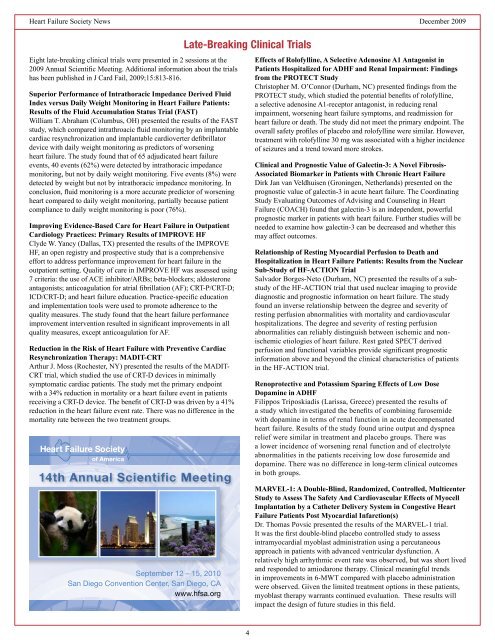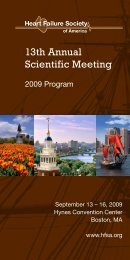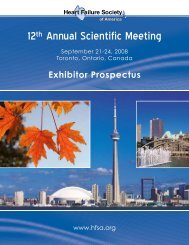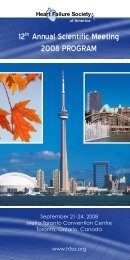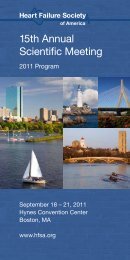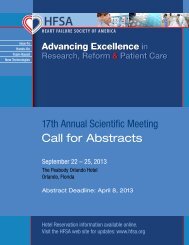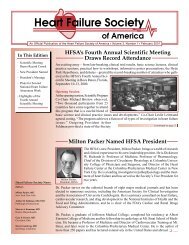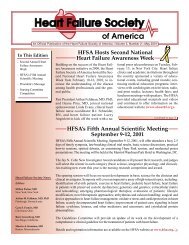Kanu Chatterjee Receives 2009 HFSA Lifetime Achievement Award ...
Kanu Chatterjee Receives 2009 HFSA Lifetime Achievement Award ...
Kanu Chatterjee Receives 2009 HFSA Lifetime Achievement Award ...
You also want an ePaper? Increase the reach of your titles
YUMPU automatically turns print PDFs into web optimized ePapers that Google loves.
Heart Failure Society News December <strong>2009</strong><br />
Eight late-breaking clinical trials were presented in 2 sessions at the<br />
<strong>2009</strong> Annual Scientific Meeting. Additional information about the trials<br />
has been published in J Card Fail, <strong>2009</strong>;15:813-816.<br />
Superior Performance of Intrathoracic Impedance Derived Fluid<br />
Index versus Daily Weight Monitoring in Heart Failure Patients:<br />
Results of the Fluid Accumulation Status Trial (FAST)<br />
William T. Abraham (Columbus, OH) presented the results of the FAST<br />
study, which compared intrathroacic fluid monitoring by an implantable<br />
cardiac resynchronization and implantable cardioverter defibrillator<br />
device with daily weight monitoring as predictors of worsening<br />
heart failure. The study found that of 65 adjudicated heart failure<br />
events, 40 events (62%) were detected by intrathoracic impedance<br />
monitoring, but not by daily weight monitoring. Five events (8%) were<br />
detected by weight but not by intrathoracic impedance monitoring. In<br />
conclusion, fluid monitoring is a more accurate predictor of worsening<br />
heart compared to daily weight monitoring, partially because patient<br />
compliance to daily weight monitoring is poor (76%).<br />
Improving Evidence-Based Care for Heart Failure in Outpatient<br />
Cardiology Practices: Primary Results of IMPROVE HF<br />
Clyde W. Yancy (Dallas, TX) presented the results of the IMPROVE<br />
HF, an open registry and prospective study that is a comprehensive<br />
effort to address performance improvement for heart failure in the<br />
outpatient setting. Quality of care in IMPROVE HF was assessed using<br />
7 criteria: the use of ACE inhibitor/ARBs; beta-blockers; aldosterone<br />
antagonists; anticoagulation for atrial fibrillation (AF); CRT-P/CRT-D;<br />
ICD/CRT-D; and heart failure education. Practice-specific education<br />
and implementation tools were used to promote adherence to the<br />
quality measures. The study found that the heart failure performance<br />
improvement intervention resulted in significant improvements in all<br />
quality measures, except anticoagulation for AF.<br />
Reduction in the Risk of Heart Failure with Preventive Cardiac<br />
Resynchronization Therapy: MADIT-CRT<br />
Arthur J. Moss (Rochester, NY) presented the results of the MADIT-<br />
CRT trial, which studied the use of CRT-D devices in minimally<br />
symptomatic cardiac patients. The study met the primary endpoint<br />
with a 34% reduction in mortality or a heart failure event in patients<br />
receiving a CRT-D device. The benefit of CRT-D was driven by a 41%<br />
reduction in the heart failure event rate. There was no difference in the<br />
mortality rate between the two treatment groups.<br />
14th Annual Scientific Meeting<br />
September 12 – 15, 2010<br />
San Diego Convention Center, San Diego, CA<br />
www.hfsa.org<br />
Late-Breaking Clinical Trials<br />
Effects of Rolofylline, A Selective Adenosine A1 Antagonist in<br />
Patients Hospitalized for ADHF and Renal Impairment: Findings<br />
from the PROTECT Study<br />
Christopher M. O’Connor (Durham, NC) presented findings from the<br />
PROTECT study, which studied the potential benefits of rolofylline,<br />
a selective adenosine A1-receptor antagonist, in reducing renal<br />
impairment, worsening heart failure symptoms, and readmission for<br />
heart failure or death. The study did not meet the primary endpoint. The<br />
overall safety profiles of placebo and rolofylline were similar. However,<br />
treatment with rolofylline 30 mg was associated with a higher incidence<br />
of seizures and a trend toward more strokes.<br />
Clinical and Prognostic Value of Galectin-3: A Novel Fibrosis-<br />
Associated Biomarker in Patients with Chronic Heart Failure<br />
Dirk Jan van Veldhuisen (Groningen, Netherlands) presented on the<br />
prognostic value of galectin-3 in acute heart failure. The Coordinating<br />
Study Evaluating Outcomes of Advising and Counseling in Heart<br />
Failure (COACH) found that galectin-3 is an independent, powerful<br />
prognostic marker in patients with heart failure. Further studies will be<br />
needed to examine how galectin-3 can be decreased and whether this<br />
may affect outcomes.<br />
Relationship of Resting Myocardial Perfusion to Death and<br />
Hospitalization in Heart Failure Patients: Results from the Nuclear<br />
Sub-Study of HF-ACTION Trial<br />
Salvador Borges-Neto (Durham, NC) presented the results of a substudy<br />
of the HF-ACTION trial that used nuclear imaging to provide<br />
diagnostic and prognostic information on heart failure. The study<br />
found an inverse relationship between the degree and severity of<br />
resting perfusion abnormalities with mortality and cardiovascular<br />
hospitalizations. The degree and severity of resting perfusion<br />
abnormalities can reliably distinguish between ischemic and nonischemic<br />
etiologies of heart failure. Rest gated SPECT derived<br />
perfusion and functional variables provide significant prognostic<br />
information above and beyond the clinical characteristics of patients<br />
in the HF-ACTION trial.<br />
Renoprotective and Potassium Sparing Effects of Low Dose<br />
Dopamine in ADHF<br />
Filippos Triposkiadis (Larissa, Greece) presented the results of<br />
a study which investigated the benefits of combining furosemide<br />
with dopamine in terms of renal function in acute decompensated<br />
heart failure. Results of the study found urine output and dyspnea<br />
relief were similar in treatment and placebo groups. There was<br />
a lower incidence of worsening renal function and of electrolyte<br />
abnormalities in the patients receiving low dose furosemide and<br />
dopamine. There was no difference in long-term clinical outcomes<br />
in both groups.<br />
MARVEL-1: A Double-Blind, Randomized, Controlled, Multicenter<br />
Study to Assess The Safety And Cardiovascular Effects of Myocell<br />
Implantation by a Catheter Delivery System in Congestive Heart<br />
Failure Patients Post Myocardial Infarction(s)<br />
Dr. Thomas Povsic presented the results of the MARVEL-1 trial.<br />
It was the first double-blind placebo controlled study to assess<br />
intramyocardial myoblast administration using a percutaneous<br />
approach in patients with advanced ventricular dysfunction. A<br />
relatively high arrhythmic event rate was observed, but was short lived<br />
and responded to amiodarone therapy. Clinical meaningful trends<br />
in improvements in 6-MWT compared with placebo administration<br />
were observed. Given the limited treatment options in these patients,<br />
myoblast therapy warrants continued evaluation. These results will<br />
impact the design of future studies in this field.<br />
4


